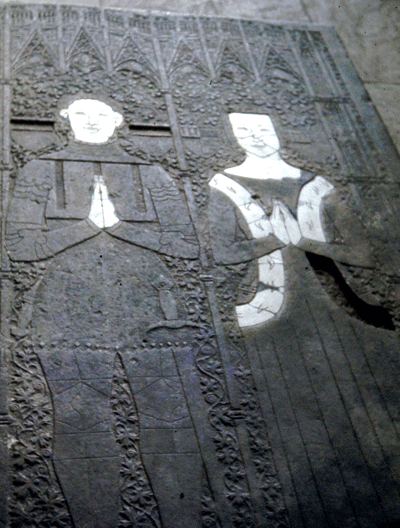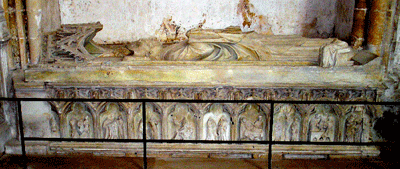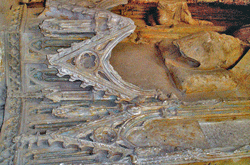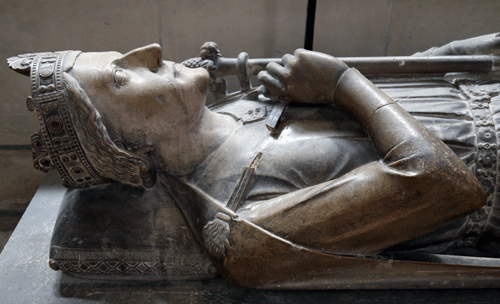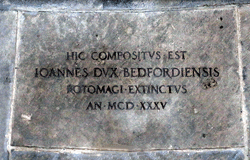 |
SEINE-MARITIME |
 |
| (Aumale) | Bailleul-Neuville | Biville-la-Baignarde | Blainville-Crevon | Bois-Guillaume | Elbeuf-sur-Seine |
| Envermeu | Eu | Fécamp | Le Havre | Hodeng-au-Bose | Jumièges |
| Limésy | Ménerval | Pavilly | Rouen | Valmont |
|
|
|||||||||
| EU | ||
| Eu is a small town
with a surprising amount of history. The church contains a fine
collection of medieval effigies while in the Chapel of Jesuits'
College are two large monuments from the time of the Wars of
Religion. You can park free outside the church; avoid the blue marked spaces which are time limited |
||
 |
The Collegiate Church of Our Lady and Saint Laurent |
 |
| This church closes on Mondays. Entry is free as is entry to the 12th century crypt where the monuments are located. There is no restriction on photography. The monuments are described in the order as you enter the crypt: first St Laurent O'Toole (on the west wall) to you left and Charles d'Artois (on the north wall) facing you. I have then described them in a clockwise direction around the walls. |
|
Laurent O'Toole, Archbishop of Dublin, fell ill and died at Eu in 1180, on his way to visit King Henry II of England, then in Normandy, to admonish him for the latter's breaking terms of the Treaty of Windsor. He was buried in the nave of the church and miracles were reported at his tomb. Pilgrims and the sick began to visit the Archbishop's tomb and the canons in due course replaced the Romanesque church with a larger and finer building. A large crypt was constructed so that pilgrims could circulate round the tomb. The Archbishop was canonised in 1226, 45 years after his death. His skull was brought to England in 1442 and buried in the parish church of Chorley, Lancashire; this was lost at the Reformation. His heart was brought to Christ Church Cathedral, Dublin but this was stolen in 2012. During the Revolution the tombs were dismantled and taken into the crypt: later the coffins opened for their lead and the bones scattered. Louis-Philippe, then Duke of Orléans and heir and successor to the counts of Eu, was the first to begin the restoration of the monuments. Only the effigies remained from the destroyed monuments and their original sites were uncertain. The effigies alone were restored, there being no attempt to rebuild the superstructure of the monuments. The drawings in the collection of Gaignières were used as a guide in this restoration. The human remains were collected and placed in an ossuary constructed below the level of the crypt. The monuments were lined against the wall with men on the left and women on the right. They were set on sarcophagi with coats of arms and surmounted by epitaphs. The restoration was complete by 1843. |
.png)  |
 |
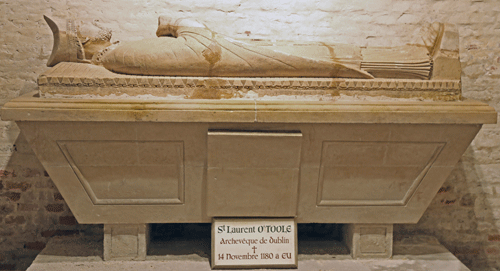 St Laurent O'Toole (1180), Archbishop of Dublin. Information about him is given above as well as links to his biography. The effigy clearly does not belong to the series of those of the Counts of Eu and the style of the effigy, as well as those of the details of the costume, dates it to the late 12th century. The restorations and mutilations are clearly seen |
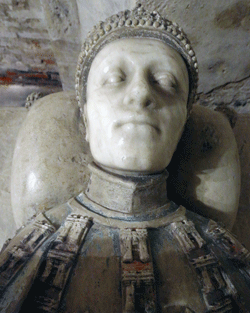 |
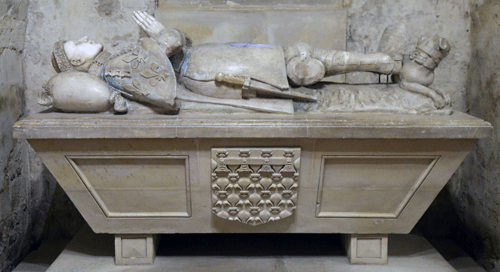 |
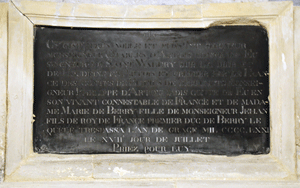 Cy gist tres noble et puissant seigneur monseigneur Charles d'Artois conte de Eu seigneur de Saint Walery sur la mer et de Houdeing en Artois et premier per de France, des contes de Eu fils de deffuncts Monseigneur Phelippe d'Artois jadis conte de Eu en son vivant connestable de France et de Madame Marie de Berry fille de Monseigneur Jehan fils du Roy de France premier Duc de Berry le quelle trespassa l'an de grace mil CCCCLXXI le XVIIᶜ jour de juillet. Priez pour luy. |
|
Charles d'Artois (1471),
son of Phillipe. The effigy is of stone but the face
and hands are of white marble. He wears the coronet of a count
and his feet rest on a dog. He played a part in the defence of the region during the invasion of Henry V during the 100 Years War but was taken prisoner at the Battle of Agincourt in 1415; he remained in captivity in England for twenty three years. He died childless and was succeeded by his nephew John II, Count of Nevers. |
||
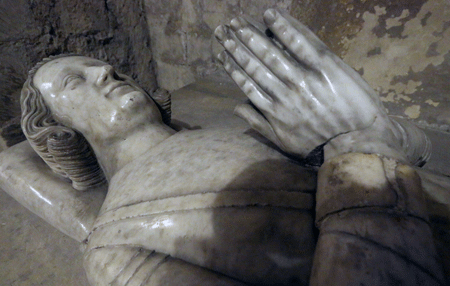 |
 |
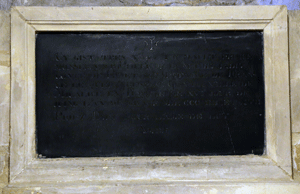 Cy gist tres noble et hault prince monseigneur Phelippe d'Artois, jadis conte de Eu et connestable de France le quel trespassa en la ville de Micalice en Turquie je XVIe jour de juing l'an de grace mil CCC IIIIxx et XVII. Priez Dieu pour l'ame de luy - Amen |
|
 |
 Philippe d'Artois (1397), son of John; he succeeded his brother Robert to the title. Effigy of white marble; feet on a lion, head and hands uncovered. The tomb was originally surrounded by a grill. A talented soldier, he was appointed Constable of France (supreme commander of the army) He went on a pilgrimage to the Holy Land but was captured and imprisoned by the sultan of Egypt, being released at the intervention of the Venetians. The Turks had now reached Hungary and he led the French contingent of an allied army - of French, English, Germans and others - to aid the king, Sigismund. The allied army was overwhelmed at the Battle of Nicopolis and Philippe was imprisoned in Analtolia where he died. The fact that Europe was at this time gripped by the Hundred Years War and weakened by the Western Papal Schism probably contributed to this defeat. |

|
|
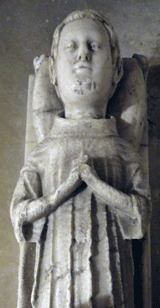 Philippe d'Artois (1397) Died in infancy. Marble wearing the coronet of a count. Feet on a lion. Son of Philippe. |
 |
 |
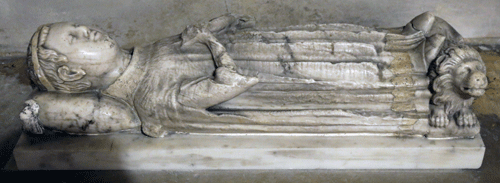 |
Cy gist Phelippe d'Artoys fils de
monseigneur Phelippe d'Artois jadis conte de Eu et
connestable de France et de madame Marie de Berry contesse
du di lieu qui trespassa
à Eu
le dymenche XXIIIe jour de décembre l'an mil IIᶜ IIIIxx et
XVIII
|
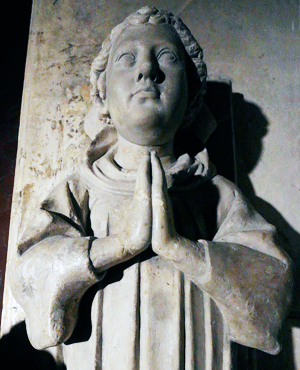 Charles d'Artois (1368) Died in childhood. Son of John & brother of Philippe. Feet on a greyhound. |
 |
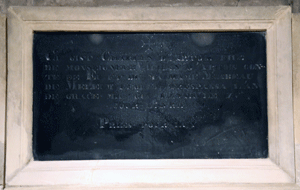 |
 |
Ci gist Charles d'Artois fils de monseigneur Jehan
d'Artois conte de Eu et de ma dame Ysabeau de Meleum lequel
trespassa l'an de grace mil CCC LXVIII le XVe jour d'avril.
Pries pour luy
|
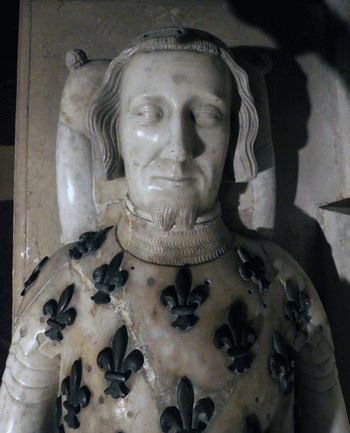 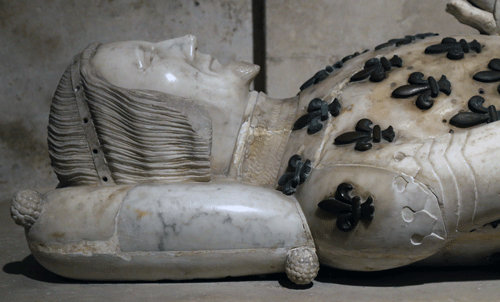 |
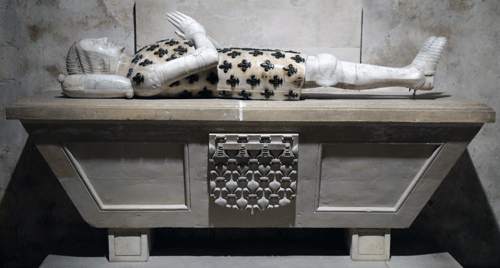 |
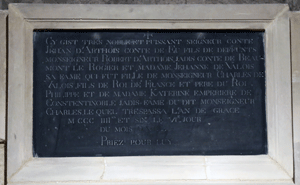
Cy gist tres noble et puissant seigneur conte Jehan
d'Arthois, conte de Eu, fils de defunts monseigneur Robert
d'Arthois jadis conte de Beaumont le Rogier et madame
Jehanne de Valois sa fame qui fut fille de monseigneur
Charles de Valois fils de Roi de France et père
de Roi Philippe et de madame Katerine emperiere de
constentinoble, jadis fame du dit monsigneur Charles le quel
trepassa l'an mil CCC IIIxx et six le VIe jour du mois
d'avril. Priez pour lui.
|
 |
||
|
Jean d'Artois (1386). White marble. The
county of Eu was given in 1350 to Jean d'Artois by King John II
('The Good'), the honour thus passing from the Brienne family to
that of Artois. John was the son of
Robert d'Artois (who, in
dispute with his overlord the French king, Phillip VI (of
Valois) fought with King Edward III against the French at the
beginning of the 100 Years War. Jean fought in the first part of the Hundred Years War and both he and King John were taken prisoners at the Battle of Poitiers and incarcerated in the Tower of London, being released after the Treaty of Brétigny brought a temporary pause to the war. This treaty in which France lost many territories, allowed the King to return to France, with Jean d'Artois, to raise the ransom. Hostages were exchanged, one of John's sons being left in England; however he escaped so breaking the terms of the treaty. The King voluntarily retuned to England, with Jean of Artois, where he died. Jean d'Artois returned to France. |
||
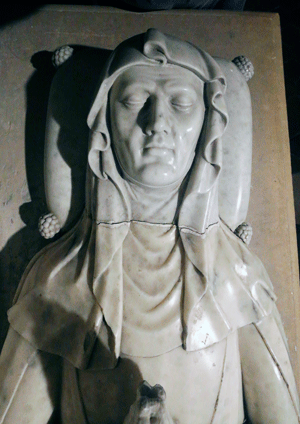 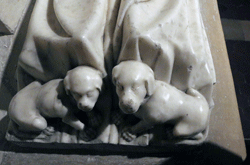 |
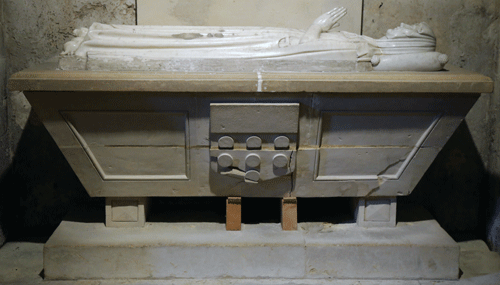 |
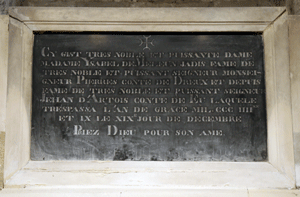  |
 Isabelle de Melun (1389) White marble. Wife of Jean d'Artois |
Cy gist tres noble et puissante dame madame Ysabel de Meleun jadis fame de tres noble et puissant seigneur monseigneur Pierres conte de Dreux et depuis fame de tres noble and puissant seigneurJehan d'Artoi conte de Eu la quelle trespassa l'an de grace Mil CCC IIIIxx et IX jour de decembre. Priez Dieu pour son âme |
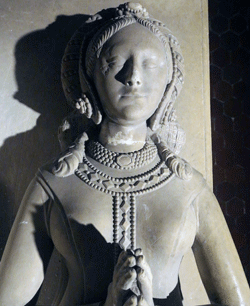  |
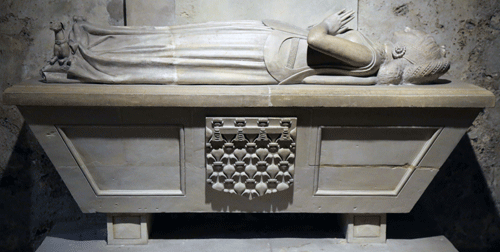 |
 |

Isabelle d'Artois (1379)
Daughter of John d'Artois and Isabelle de Melun
|
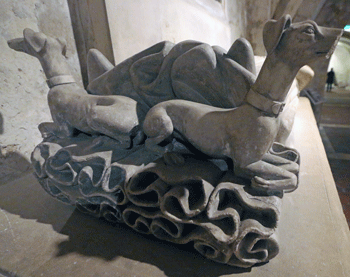 |
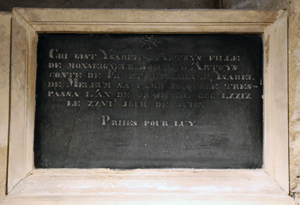 |
Chi gist Ysabel d'Artois fille de monseigneur Johan
d'Artoys conte de Eu et de madame Ysabel de Meleun so fame
laquele trespassa l'an de grace mil CCC LXXIX le XXVIe jour
de juing. Priies pour luy
|
  |
 |
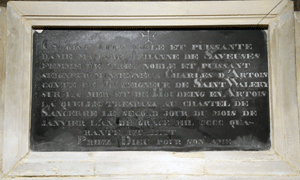  Cy gist tres noble et puissante dame madame Jehanne de Saveuses femme de tres noble et puissant seigneur monseigneur Charles d'Artois conte de Eu seigneur de Saint Walery sur la mer et de Houdeing en Artois la quelle trespassa ou chastel de Sancerre le second jour de mois de janvier l'an de grace mil CCCC quarante et huite. Priez Dieu pour son âme. |
 Jeanne de Saveuse (1448) First wife of Charles d'Artois |
 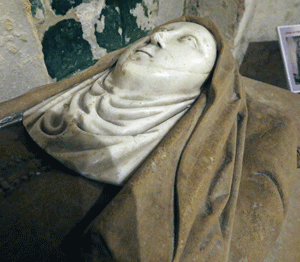 |
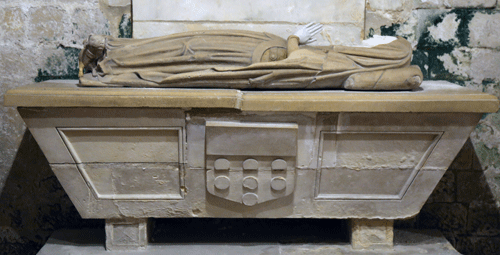 |
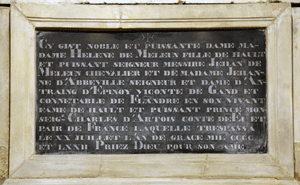 |
 Hélèlne de Melun (1472) Of stone with face and hands of white marble. Second wife of Charles d'Artois |
Cy gist noble et puissante dame madame Héléne
de Muleun fille de hault et puissant seigneur messire Jehan
de Melun chevalier et de madame Jehanne d'Abbeville
seigneur et dame d'Antraing d'Epinoy viconte de
Gand et connestable de Flandre en son vivant fame de hault
et puissant prince monseigneur Charles d'Artois conte de Eu et
pair de France laquelle trespassa le XX juillet l'an de grace
mil CCCC et LXXII. Priez pour son âme
|
Drawings in the Gaignières Collection of Monuments at Eu |
|
 |
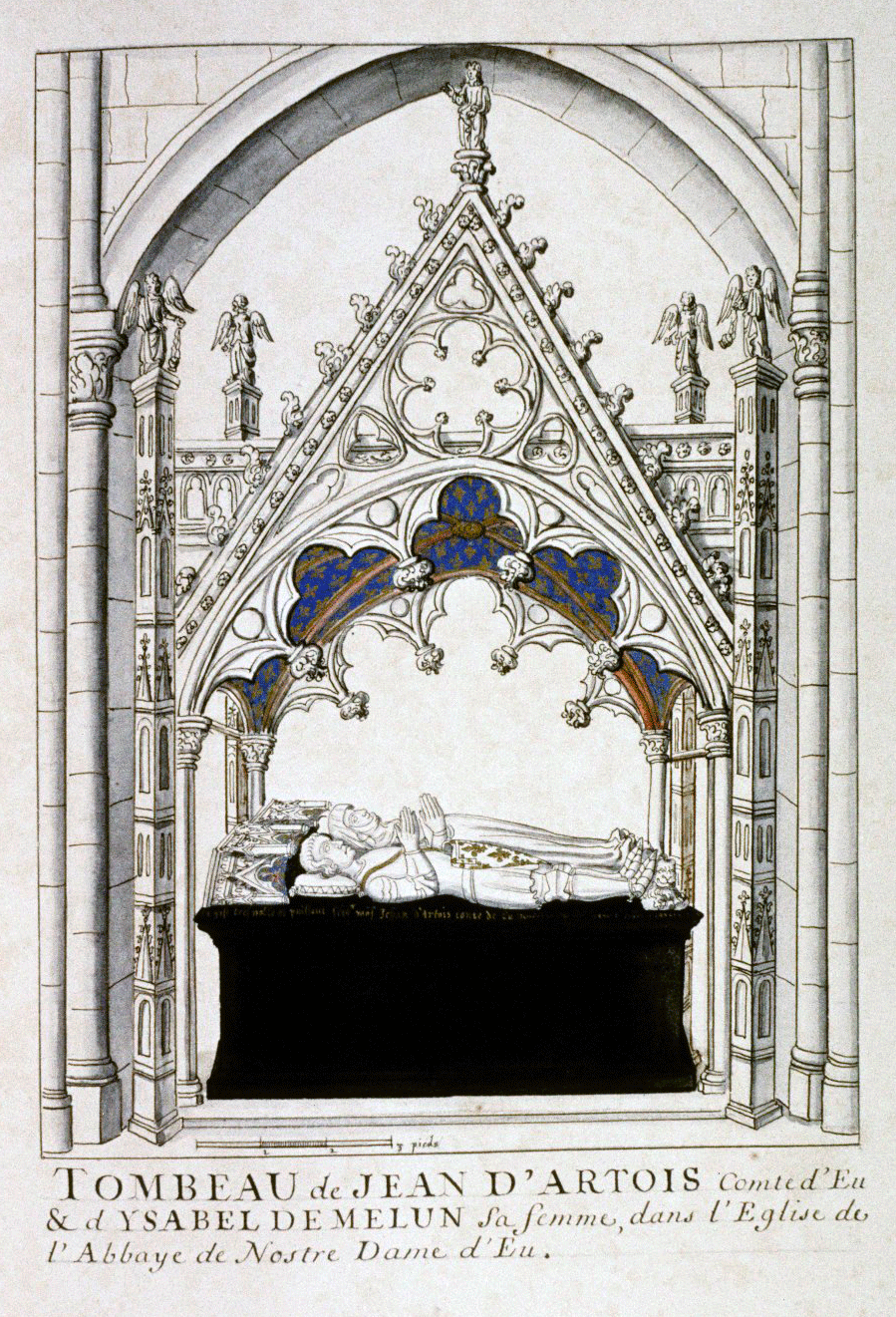 |
To date I have only been able to discover the above two drawings, of the same monument, of the monuments at Eu in the Gaignières collection. They show that the monuments were almost certainly in the body of the church rather than the crypt where the effigies are now situated. They also show that the monuments (or, at least this one) were very fine indeed with an elaborate canopy and gablets above the heads of the effigies. The effigies in this example are paired - man with wife - and lie on a double tomb chest which has an inscription written around the edge of the upper slab of this chest. This can just be made out in the illustration, although hardly decipherable, and reads:
Cy gist tres noble et puissant seigneur Monseigʳ
Jean d'Artois, Compte d'Eu fils de deffunt Monseigʳ
However the explanation below the drawings states that the monument is that of Jean d'Artois and Ysabel de Melun. If the drawings are compared with the photographs above it will be seen that, although the female effigies correspond, the drawing is stated to be that of Jean d'Artois and not Jean, as is stated on the epitaph in the church. The photograph shows that the effigy stated to be Jean in the church does not carry a shield, wears a jupon semé with fleurs de lys and wears a band around his hair as well as a beard. It is therefore very likely that the above drawing names the effigies correctly and that given in the church on the epitaph is incorrect. Charles Stothard also visited Eu on his travels in Normandy and made drawings of some of these effigies. These were never turned into effigies and never published; they are in a privated collection. |
|
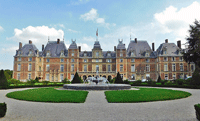 |
Château of Eu |
| The château is open to the public for a modest fee. (€5.00 in 2017) It is in effect a museum | |
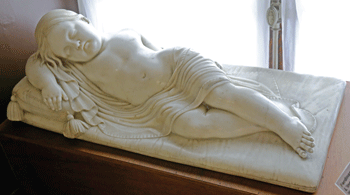
This effigy of a sleeping child may
have been intended to be a church monument or a copy of
a church monument, but I was unable to gain any
information.
|
|
 |
Chapel of
Jesuits' College (early 17th century) |
 |
| No charge for entry or photography. Park as for church. There was an exhibition of fine glass in the nave when we visited. |
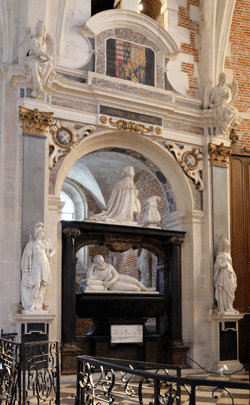 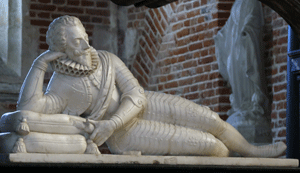 |
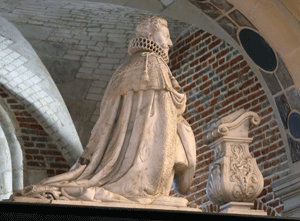 |
 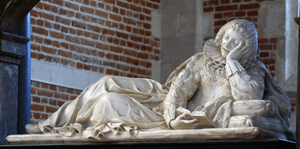 |
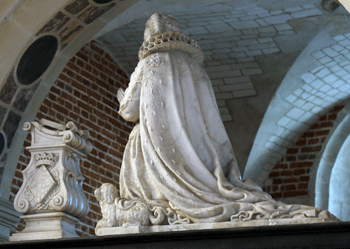 On either side of the chancel: Henry of Lorraine, Duke of Guise (1588) and Catherine of Clèves (1633) |
Henry, Duke of Guise often appears as the French equivalent to the nasty Tudor Dukes of Norfolk in film and television dramatisations. One of the Catholic leaders in the French wars of religion, he founded the Catholic League in order to prevent the Huguenot Henri, King of Navarre, succeeding to the French throne. He was responsible for arranging the murder of Admiral Coligny, the Huguenot leader, whom he considered to have organized the murder of his father; this murder of Coligny was followed by the horrific St Bartholomew's Day Massacre. The weak and vacillating King Henry III initially sided with the Catholic League but not wishing to be a mere puppet to the Duke and following the defeat of the Spanish Amada (the Spanish supported the Catholic league) his support waned. He invited the Duke and the latter's brother, Louis II, Cardinal of Guise, to the Château of Blois where the Duke was summoned to the King's presence in a private chamber; there two of the royal guard (the '45') killed the Duke in front of the King; his brother, the Cardinal, was killed by the guard the following day. The following Henry day himself was assassinated by a fanatical Catholic, the friar Jacques Clément, who was at once killed by the King's guard. |
| City of Rouen |
| Park in the underground car park near the cathedral at relatively modest cost; or in one of the other car parks. All the buildings described are within reasonable walking distance, although you may prefer to drive to the museum, which is on the outer part of the city, and park nearby. |
 |
The Cathedral Cathedral Church of Notre-Dame |
 |
 |
| Open daily (except Monday mornings) but check website. There is no charge for entry or photography. Rouen was the capital of the Duchy of Normandy and the Cathedral the burial place of its early Dukes. |
| The Ambulatory |
|
|
 |
 |
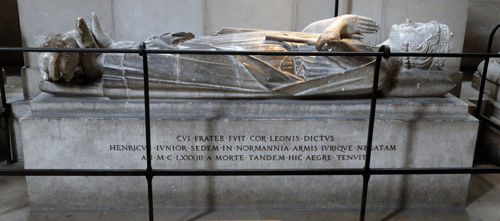 |
Henry - The Young King (ob 1183) Henry was the eldest son of King Henry II (and hence Richard's brother) who was crowned in his father's lifetime. He rebelled against his father and died young, Richard then succeeding to their father's estates. His 13th century monument was destroyed in 1736 during 'improvements' by the cathedral authorities. However the badly damaged effigy was discovered, like that of Richard, during excavations. It was a very poor condition but restored at the Museum of Antiquities in Rouen. CUI.FRATER.FUIT.COR.LEONIS.DICTUS.HENRICUS. IUNIOR.SEDEM.IN.NORMANNIA.ARMIS.IURIQUE. NEGATAM. AN.M.C.LXXXIII.A.MORTE.TANDEM. HIC.ABGRE.TENUIT. |
 |
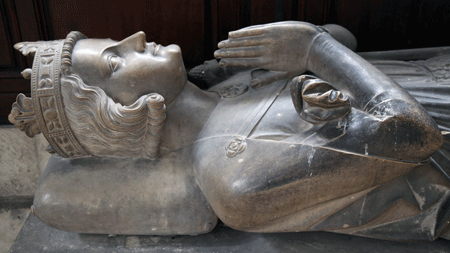 |
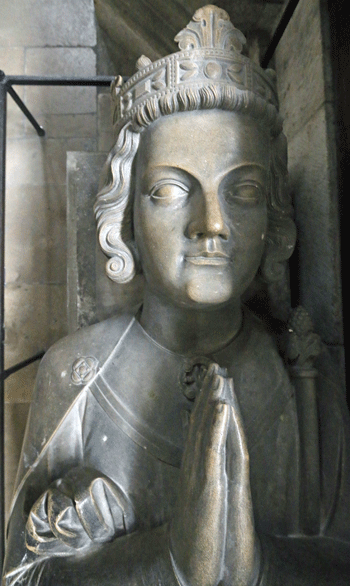 |
| Rollo, Duke of
Normandy (c 933)This is a
modern copy of the effigy accidentally destroyed
by bombs during
World War II. A photograph of the original may be seen
below IN.SINU.TEMPLI.ROLLO.QUIESCIT.A.SE.VASTATAE.CONDITAE.NORMANNIAE. PATER.AC.PRIMUS.DUX.LABORE.QUI.FRACTUS. OCCUBUIT.OCTOGENARIO.MAIOR.AN.CM.XX Rollo was a pagan Viking but was baptized here in 915 and buried here in 933. He was the founder of the Duchy of Normandy and father of William Longsword (below) |
||
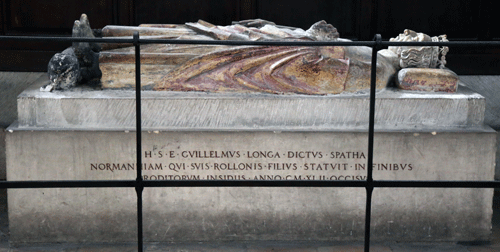 |
 |
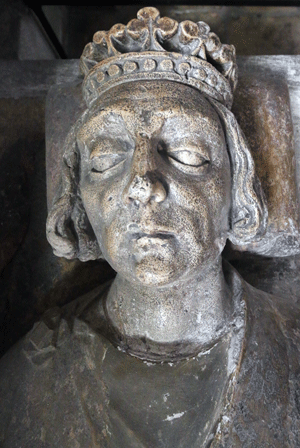 |
| William Longsword, Duke of Normandy
(942) 13th Century
effigy H.S.E.GUILLELMUS.LONGA.DICTUS.SPATHA. NORMANNIAM.QUI.SUIS.ROLLONIS.FILIUS.STATUIT .IN.FINIBUS.PRODITORUM.INSIDUS.ANNO.CM.XLII.OCCISUS |
||
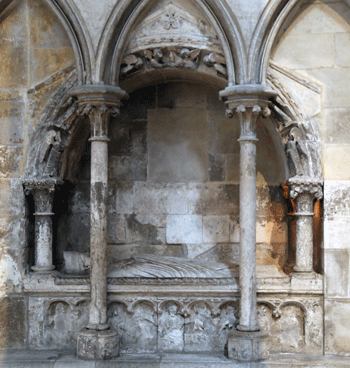 |

Hugh
III of Amiens, Archbishop of Rouen
(1164)
Said to be the oldest recumbent effigy in France. |
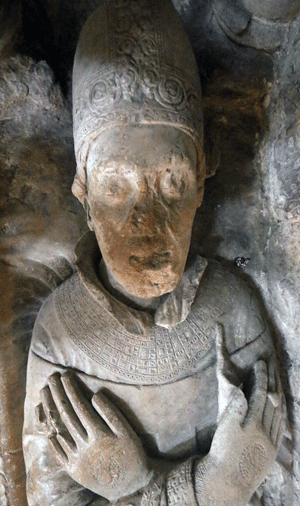 |
| Lady
Chapel (annoyingly locked) |
St Joan of Arc's Chapel | ||
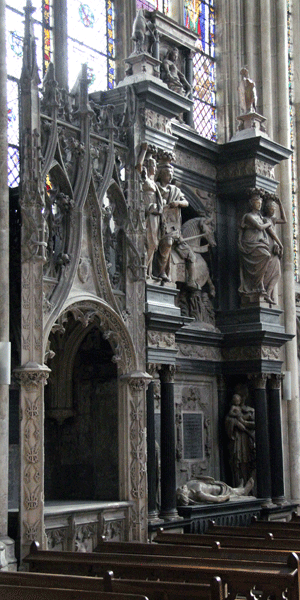 |
 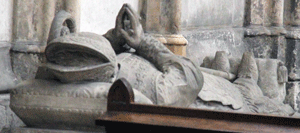 Above top: Cardinal Henri-Marie-Gaston Boisnormand de Bonnechose (1885) Archbishop of Rouen. By Chapu (1891) Above bottom: Cardinal Gustave Maximillien Juste de Croy-Soire (1844) Archbishop of Rouen 1824-44. By Fulconis (1856) These two monuments are against the north wall on either side of de Brézé tombs. |
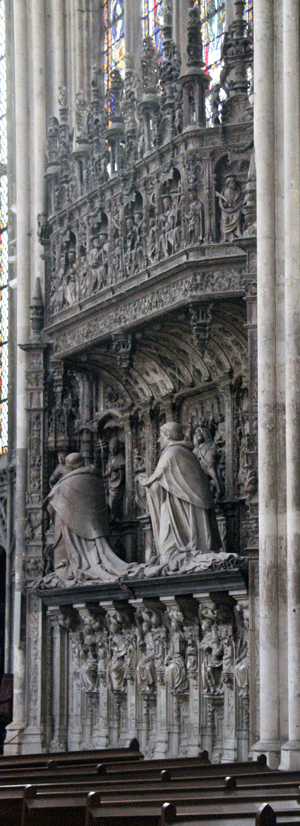 |
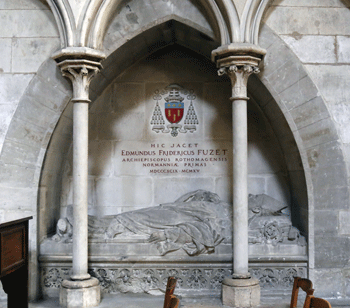 
Archbishop Frédéric
Fuzet (1899)
By Gauquié(1918)
|
|
Above far left: On the right of the photograph is the tomb of Louis de Brézé (1531) Seneschal of Normandy. He was grandson of Agès Sorrel and married Diane de Poitiers. Cadaver effigy below with an equestrian effigy above. On either side of the cadaver are carved the figures of a kneeling Diane de Poiters and the Virgin and Child. On either side of the equestrian effigy stand a pair of caryatids. On the uppermost structure sits a woman who alone represents the Four Cardinal Virtues. By Jean Cousin & Jean Gonjon . On the left of the photograph and to the left of the Louis de Brézé tomb is the tomb of his grandfather Pierre de Brézé (1465) Minister of Charles VII. He accompanied Margaret of Anjou to Scotland with a force of 2000 men but brought her back to Flanders after the Battle of Hexham. He died at the Battle of Montlhéry. The tomb was constructed in 1488. The effigies Pierre de Brézé and his wife were removed in 1769 by the canons. Above centre right: The Cardinals d'Amboise, Georges I & II (uncle and nephew), Archbishops of Rouen 1515-1525. George I was a minister of Louis XII and Papal legate. The tomb was originally conceived for George I only, construction beginning in 1515 and being completed in 1512; it was then modified in 1525 to incorporated the statue of Georges II. The work was overseen by Rouland Le Roue and the sculptors were João de Ruão and Pierre des Aubeaux. On the base of the monument are figures of the Six Vertues and between them much smaller 'weepers', behind the cardinals a prominent St George and the Dragon and above and surrounding figures of Saints and Apostles. |
|||
The Lady Chapel is closed off from the main body of the church by a high metal grill with a locked gate because of the 'fear of depredations', which is rather ironic considering the fact that the cathedral authorities themselves were responsible for the destruction of several medieval tombs as well as two effigies in this chapel in the name of 'improvements.' Unfortunately there are several magnifigent monuments sited in this part of the cathedral and the only way I have been able to photograph them is with a long lens over the top of the grill, which is far from satisfactory. |
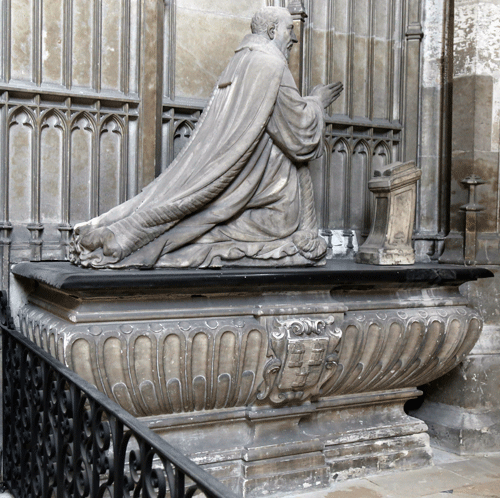 |
Chapel of Saint Etienne-la-Grande-Eglise |
| This chapel is behind the bookstall but reasonably accessible | |
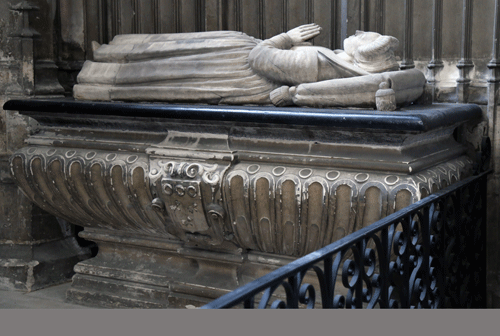 |
|
| Left: Claude
Grulard (1607) First presidents of the
parliament of Normandy. Above: Barbe Guiffard (1599) his wife Both effigies are of white marble and of the 17th century. The monuments were originally installed in the church of Célestins de Rouen but were transferred to the cathedral in 1865 |
| Some Tales of Burials and Monuments and their Destruction in the Cathedral |
Henry the Young King died of dysentery at Martel (Limousin) at the age of 28 in 1183, while campaigning against his father, Henry II, and his brother, the future Richard I. He had wished to be buried at Rouen but when his funeral procession halted at Le Mans a group of citizens appeared and buried his body in the cathedral, with the bishop of Le Mans presiding over the ceremony. The citizens of Rouen were outraged and threatened to raise Le Mans to the ground if the Young King's body were not restored to them for burial in their cathedral. Leading men who were with the Young King before his death wrote to the pope confirming Young Henry's wish of his place of burial. When Henry II was convinced of his son's wishes, he intervened and ordered the body be transported to Rouen, so avoiding a possible war of the cathedral cities. It is not known if an effigy was commissioned at this time for his tomb but around 1300 the cathedral authorities commissioned a series of effigies for the early dukes, who had been buried there and his effigy may have been part of that series. Other burials in the cathedral were William Fitzempress (1164) , Henry's uncle, and after his death, Arthur, Duke of Brittany (1203), his cousin, and the heart of his brother, Richard I; his grandmother, the Empress Matilda, was also buried in the cathedral as late as 1846 following the destruction of he original burial site, the Abbey of Bec-Hellouin. Richard's heart burial was also surmounted by an effigy but I do not know how this other burial sites were marked. The heart of King Charles V (of France) was also buried in the cathedral and marked by a lost monument, a drawing of which is shown below; he died in 1380. The monument of John, Duke of Bedford was surmounted by an effigy which was destroyed during the Religious Wars in 1562; it may well have been made of metal, which would explain this destruction. This was replaced by a plain black marble tomb chest in the 17th century, which was itself removed during the remodeling of the sanctuary in the 1730's In 1734 the canons of the cathedral decided to elevate the floor of the sanctuary considerably above the surrounding levels. This involved the demolition of several tombs in this area, namely, those of Henry the Young King, Richard I, John, Duke of Bedford and that over the heart burial of the French king Charles V. Only inscribed stones were inserted in the floor giving details of the burials, although remains were reburied in the original sites. Beginning in 1838, excavations in the cathedral discovered the effigy of Richard I buried underneath the original monument site and below this was a lead casket, enclosed in a cavity, with lettering indicating that it contained the heart of the king. This, with the fragments of the king's heart, are now in the Museum of Antiquities, Rouen, while the effigy, which had remained in reasonable condition, was restored and mounted on a plinth, originally one which was quite out of keeping, but later the plain one that we see today. A not very accurate drawing of the monument before its destruction can be see below; this shows the effigy mounted on a slab supported by four lion, a designed which may been see in France at that time. The effigy of the Young King was discovered 1866 buried below it original site but, unlike that of Richard, in a very mutilated condition. It was restored and eventually returned to the cathedral; it is not a replacement as sometimes stated. I have not discovered the fate of the other monuments. |
 Above is a drawing of the tomb of Pierre de Brézé (see above) before the removal of the effigies of him and his wife Jeanne de Bec Crespin. |
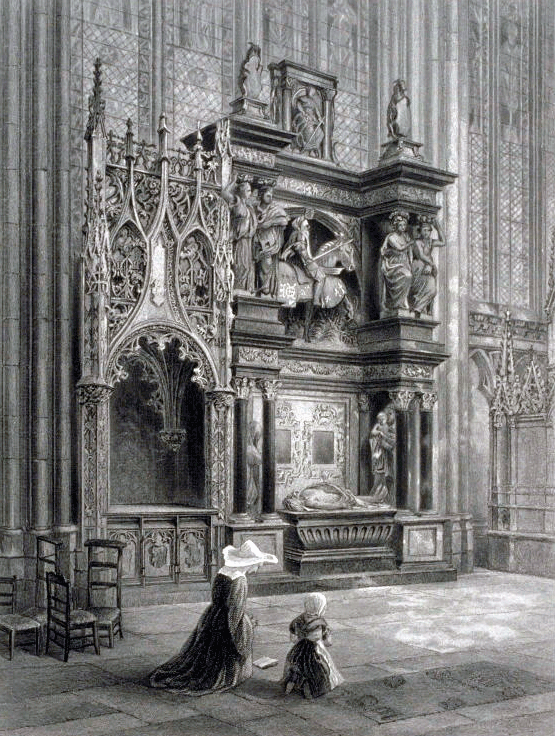 Above: Print of the above (with effigies removed) with next the adjacent tomb of Louis de Brézé (see above). The upper stage of this latter tomb contains an equestrian statue of the commemorated with four figures representing Victory, Faith, Prudence and Glory to either side. Below he is shown as a shrouded corpse; at his head is grieving Diane de Poitiers and at his feet the Virgin and Child |
 Above: Print (reversed!) of the The Cardinals d'Amboise tomb |
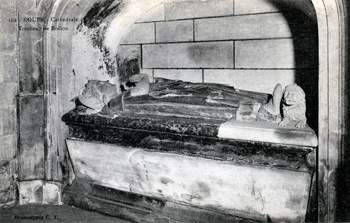
Above: Photograph of the effigy of Rollo
before its destruction by bombing during World War
II. This shows that it was not sited in the present
position of its replacement but rather in a niche in
the wall.
I assume that that of William Longsword was also in a similar position which explains why they were not destroyed during the 'remodeling' of the choir. |
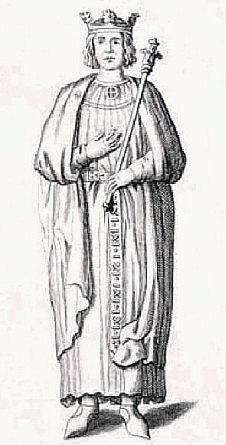 |
 |
 |
Drawing of the original effigy of Henry, the Young King |
Drawing the original monument of Richard I. Only the actual effigy now remains | Drawing over the monument of the heart burial of Charles V |
 |
Abbey Church of Saint-Ouen 3 Place de Général de Gaulle |
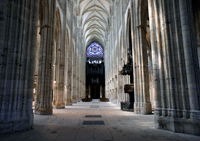 |
| Park as for the cathedral. Again
there is no charge for entry or photography. The opening
times are restricted, see below. Another large and fine
church in this city These two monuments are in the lady chapel. Like the cathedral this is closed off by a high metal grill entered by a locked gate but it also seems to be used as a store of various objects, some very large, so making photography difficult. Closed Monday and Friday. Open 10.00am-12.00noon & 14.00pm-5.00pm (6.00pm April - October) Check website |
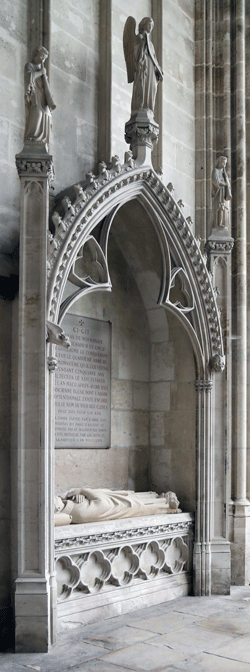 |
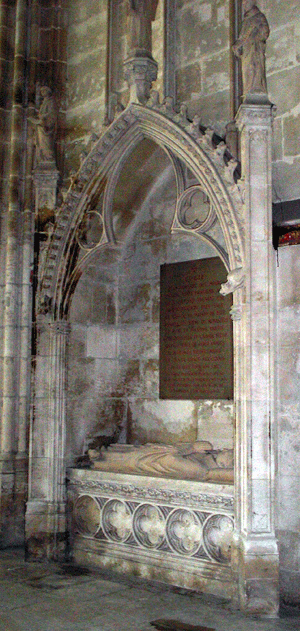 |
| North Wall. Nicolas de Normandie (1092) 4th abbot. Builder of the Romanesque church. Uncle of William the Conqueror. Tomb raised by Jean Roussel (see below) | South Wall. Jean
Roussel (1339) called Marc-Argent. 23rd
abbot of Saint-Ouen. He built the gothic church. Both of these tombs was destroyed but rebuilt in 1869 |
|
Musée des Antiquities 198 Rue Beauvoisine |
| You can walk to the museum from the
city centre or street park very near (charged) or park a
very short walk away free of charge. This is a small,
helpful and very friendly museum; unlike many French
museum entry is free of charge. Photography is allowed but
there is a bag search. Pleasant gardens for a picnic. No
on site parking.
Toilets. The opening hours are contradictory: they seem to be Tuesday to Saturday 1.30pm to 5.30pm and Sunday 2.00pm to 6.00pm but important to check website. |
 |
 |
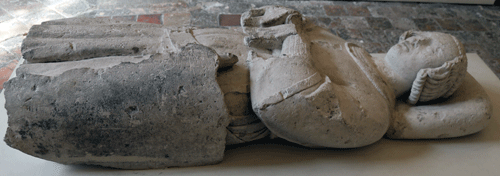 |
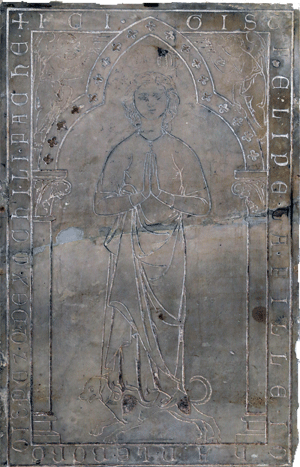 |
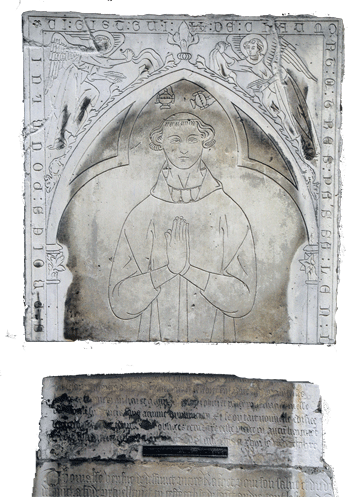 |
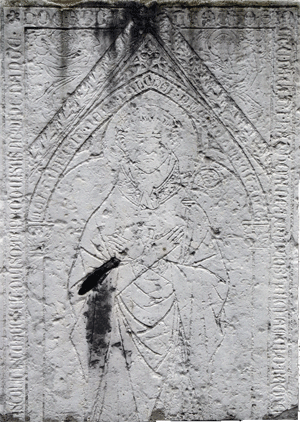 |
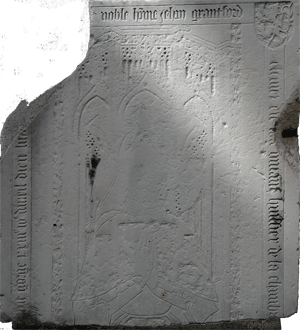 |
| Felipe, daughter of Johan le Bourgois | Gui II de Chaumont priest | Jehan Grantford (1481) Usher of the chamber to King Edward IV of England. From Eglise de Jacobins, Rouen. (Greenhill) |
The casket containg the heart of Richard the Lion Heart is in the Museum but in storage and not on display
